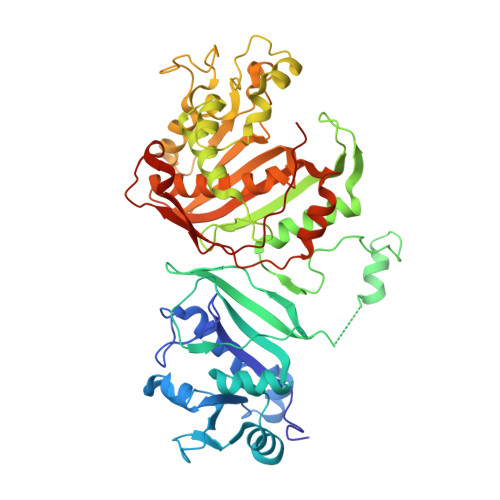Inhibitor-bound complexes of dihydrofolate reductase-thymidylate synthase from Babesia bovis.
Begley, D.W., Edwards, T.E., Raymond, A.C., Smith, E.R., Hartley, R.C., Abendroth, J., Sankaran, B., Lorimer, D.D., Myler, P.J., Staker, B.L., Stewart, L.J.(2011) Acta Crystallogr Sect F Struct Biol Cryst Commun 67: 1070-1077
- PubMed: 21904052
- DOI: https://doi.org/10.1107/S1744309111029009
- Primary Citation of Related Structures:
3I3R, 3K2H, 3NRR - PubMed Abstract:
Babesiosis is a tick-borne disease caused by eukaryotic Babesia parasites which are morphologically similar to Plasmodium falciparum, the causative agent of malaria in humans. Like Plasmodium, different species of Babesia are tuned to infect different mammalian hosts, including rats, dogs, horses and cattle. Most species of Plasmodium and Babesia possess an essential bifunctional enzyme for nucleotide synthesis and folate metabolism: dihydrofolate reductase-thymidylate synthase. Although thymidylate synthase is highly conserved across organisms, the bifunctional form of this enzyme is relatively uncommon in nature. The structural characterization of dihydrofolate reductase-thymidylate synthase in Babesia bovis, the causative agent of babesiosis in livestock cattle, is reported here. The apo state is compared with structures that contain dUMP, NADP and two different antifolate inhibitors: pemetrexed and raltitrexed. The complexes reveal modes of binding similar to that seen in drug-resistant malaria strains and point to the utility of applying structural studies with proven cancer chemotherapies towards infectious disease research.
Organizational Affiliation:
Seattle Structural Genomics Center for Infectious Disease (http://www.ssgcid.org), USA. [email protected]





















